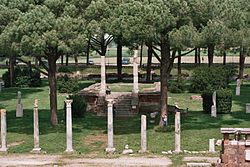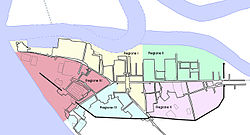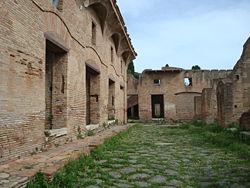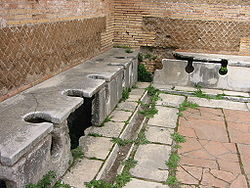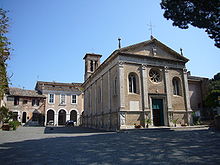- Ostia Antica
-
Ostia Antica is a large archeological site, close to the modern suburb of Ostia (Rome), that was the location of the harbour city of ancient Rome, which is approximately 30 km to the northeast. "Ostia" in Latin means "mouth". At the mouth of the River Tiber, Ostia was Rome's seaport, but, due to silting and a drop in sea level, the site now lies 3 km from the sea.[1] The site is noted for the excellent preservation of its ancient buildings, magnificent frescoes and impressive mosaics.
Contents
History
Origins
Ostia may have been Rome's first colonia. An inscription[citation needed] says that Ostia was founded by Ancus Marcius, the semi-legendary fourth king of Rome, in the 7th century BC.[2] The oldest archaeological remains so far discovered date back to only the 4th century BC. The most ancient buildings currently visible are from the 3rd century BC, notably the Castrum (military camp); of a slightly later date is the Capitolium (temple of Jupiter, Juno and Minerva). The opus quadratum of the walls of the original castrum at Ostia provide important evidence for the building techniques that were employed in Roman urbanisation during the period of the Middle Republic.
Sacking by pirates
In 68 BC, the town was sacked by pirates.[3] During the sacking, the port was set on fire, the consular war fleet was destroyed, and two prominent senators were kidnapped. This attack caused such panic in Rome that Pompey Magnus arranged for the tribune Aulus Gabinius to rise in the Roman Forum and propose a law, the Lex Gabinia, to allow Pompey to raise an army and destroy the pirates. Within a year, the pirates had been defeated.
The town was then re-built, and provided with protective walls by the statesman and orator Marcus Tullius Cicero.[citation needed]
Imperial Ostia
The town was further developed during the first century AD under the influence of Tiberius, who ordered the building of the town's first Forum. The town was also soon enriched by the construction of a new harbor on the northern mouths of the Tiber (which reaches the sea with a larger mouth in Ostia, Fiumara Grande, and a narrower one near to the current Fiumicino International Airport). The new harbor, not surprisingly called Portus, from the Latin for "harbor," was excavated from the ground at the orders of the emperor Claudius. This harbour became silted up and needed to be supplemented later by a harbor built by Trajan finished in the year AD 113; it has a hexagonal form, in order to reduce the erosive forces of the waves. This took business away from Ostia itself (further down river) and began its commercial decline.
Ostia itself was provided with all the services a town of the time could require; in particular, a famous lighthouse. Ostia contained the Ostia Synagogue, the earliest synagogue yet identified in Europe; it created a stir when it was unearthed in 1960-61.[4] By 1954 eighteen mithraea had also been discovered: Mithras had his largest following among the working population that were the majority of this port town. Archaeologists also discovered the public latrinas, organized for collective use as a series of seats that allow us to imagine today that the function was also a social moment. In addition, Ostia had a large theatre, many public baths, numerous taverns and inns, and a firefighting service.
Trajan too, required a widening of the naval areas, and ordered the building of another harbor, again pointing towards the north. It must be remembered that at a relatively short distance, there was also the harbor of Civitavecchia (Centum Cellae), and Rome was starting to have a significant number of harbours, the most important remained Portus.
Late-Roman and sub-Roman Ostia
Ostia grew to 50,000 inhabitants in the 2nd century, reaching a peak of some 75,000 inhabitants in the 2nd and 3rd centuries AD.[citation needed] Ostia became an episcopal see as early as the 3rd century, the cathedral (titulus) of Santa Aurea being located on the burial site of St. Monica, mother of Augustine; she died in an inn in the town. In time, naval activities became focused on Portus instead. A slow decadence began in the late Roman era around the time of Constantine I, with the town ceasing to be an active port and instead becoming a popular country retreat for rich aristocrats from Rome itself (along the lines of Brighton's relationship to London in the 18th century).[citation needed]
The decaying conditions of the city were mentioned by St. Augustine when he passed there in the late 4th century.[citation needed] The poet Rutilius Namatianus also reported the lack of maintenance of the city in 414.
With the end of the Roman Empire, Ostia fell slowly into decay, and was finally abandoned in the 9th century due to the repeated invasions and sackings by Arab pirates, including the Battle of Ostia, a naval battle in 849 between Christian and Saracens; the remaining inhabitants moved to Gregoriopolis.[citation needed]
Sacking and excavation
A "local sacking" was carried out by Baroque architects, who used the remains as a sort of marble storehouse for the palazzi they were building in Rome. Soon after, foreign explorers came in search of ancient statues and objects. The Papacy started organizing its own investigations with Pope Pius VII; under Mussolini massive excavations were undertaken from 1938 to 1942. The first volume of the official series Scavi di Ostia appeared in 1954; it was devoted to a topography of the town by Italo Gismondi and after a hiatus the research still continues today. Though untouched areas adjacent to the original excavations were left undisturbed awaiting a more precise dating of Roman pottery types, the "Baths of the Swimmer", named for the mosaic figure in the apodyterium, were meticulously excavated, 1966–70 and 1974–75, in part as a training ground for young archaeologists and in part to establish a laboratory of well-understood finds as a teaching aid. It has been estimated that two thirds of the ancient town have currently been found.
In popular culture
- Ostia was featured in the novels I, Claudius and Claudius the God, both written by British novelist Robert Graves. The novels include scenes set at Ostia spanning from the reign of Augustus to the reign of Claudius, including the departure of Agrippa to Syria and Claudius's reconstruction of the harbour. In the 1976 television series, Ostia was frequently mentioned but never actually seen.
- Ostia forms the main setting for "The Roman Mysteries" series of historical novels for children by Caroline Lawrence. The first book is titled "The Thieves of Ostia" and centers on Nubia, Johnathan, Lupus and Flavia.
- Ostia appears briefly towards the end of the Roman Empire section of the 1981 comedy film History of the World, Part I, where the main characters board a galleon (bearing the El Al logo) bound for Judaea. In the film, however, Ostia is only ever referred to as simply "the port".
- Ostia is mentioned in the 2000 film Gladiator, when the protagonist Maximus learns that his army is camped at Ostia and awaiting orders.
- One of the wonders buildable in the "Rise and fall of the Roman Empire" mod for Sid Meier's Civilization III is called the "Portus Ostiae"
- Ostia is the name of the Magic World's lost kingdom and the location of the gladiatorial games in the manga series Negima!.
Photos
Notes
- ^ OSTIA Harbour City of Ancient Rome (2008), "Ostia-Introduction", "The ancient Roman city of Ostia was in antiquity situated at the mouth of the river Tiber, some 30 kilometres to the west of Rome. The shoreline moved seawards, due to silting, from the Middle Ages until the 19th century. Therefore Ostia is today still lying next to the Tiber, but at a distance of some three kilometers from the beach. Ostia is Latin for "mouth", the mouth of the Tiber. The river was used as harbour, but in the Imperial period two harbour basins were added to the north, near Leonardo da Vinci airport. The harbour district was called Portus, Latin for "harbour"."
- ^ "Ancus Marcius, the fourth of the kings from Romulus after the founding of the city [Rome] founded this first colony" (Anco Marcio regi quarto a Romulo qui ab urbe condita primum coloniam --- deduxit).
- ^ Robert Harris, "Pirates of the Mediterranean" New York Times, 30 September 2006
- ^ L. Michael White, "Synagogue and Society in Imperial Ostia: Archaeological and Epigraphic Evidence" The Harvard Theological Review 90.1 (January 1997), pp 23-58; Anders Runesson, "The Oldest Original Synagogue Building in the Diaspora: A Response to L. Michael White" HTR 92.4 (October 1999), pp 409-433; L. Michael White "Reading the Ostia Synagogue: A Reply to A. Runesson", HTR 92.4 (October 1999), pp 435-464.
References
- Hermansen, Gustav 1982. Ostia: Aspects of Roman City Life (Edmonton: University of Alberta Press)
- Meiggs, R. (1960) 1973. Roman Ostia 2nd ed. (Oxford University Press) The standard overview.
- Packer, James E. 1971 The Insulae of Imperial Ostia" M.Am.Acad. Rome 31
- Pavolini, C. 'Ostia: Guida Archeologica Laterza (Rome:Laterza) (Italian)
- Lorenzatti Sandro, Ostia. Storia Ambiente Itinerari Roma 2007 (Rome:Genius Loci)
External links
- Ostia Antica, The Better Pompeii
- Ancient Ostia Virtual panoramas and photo gallery (English) (Italian)
- Ostia — Harbor City of Ancient Rome including an introduction (English)
- The Roman Theatre at Ostia Antica The Ancient Theatre Archive. Theatre specifications and virtual reality tour of the ancient theatre (English)
- Ostia Antica Travel Guide VIDEO including a Computer reconstruction (English)
- Map, Directions and Practical Information
Categories:- Roman towns and cities in Italy
- Ancient Roman buildings and structures in Rome
- Archaeological sites in Italy
- Roman sites in Lazio
- Mithraea
- Former populated places in Italy
- Mediterranean port cities and towns in Italy
- Visitor attractions in Rome
Wikimedia Foundation. 2010.

